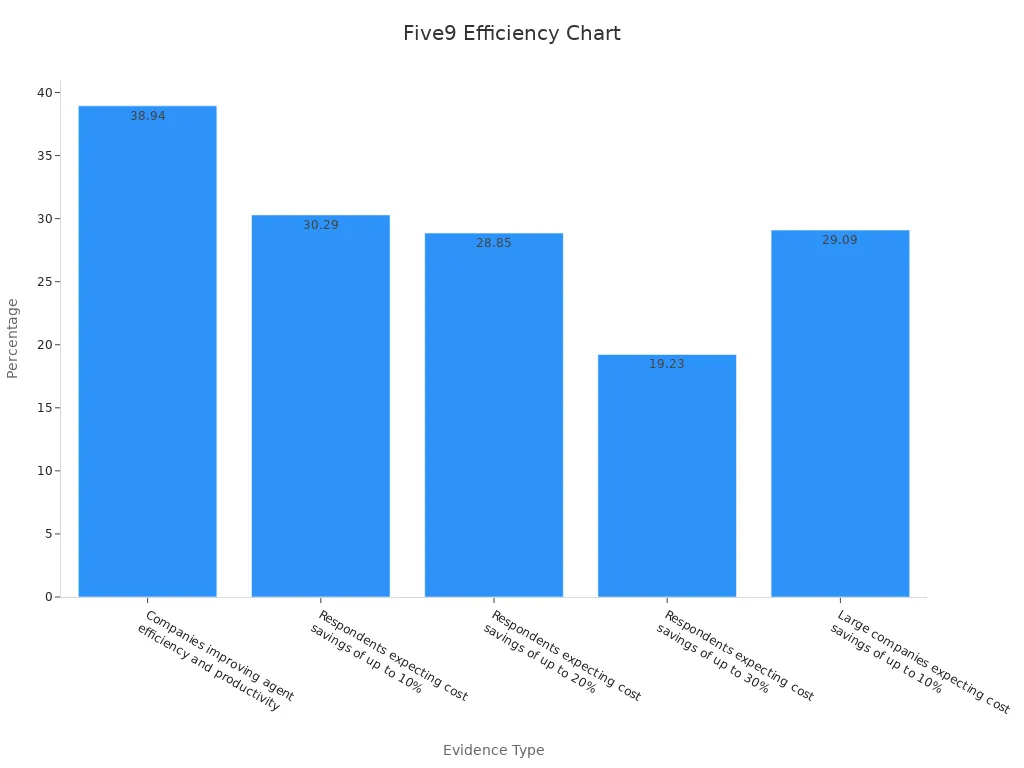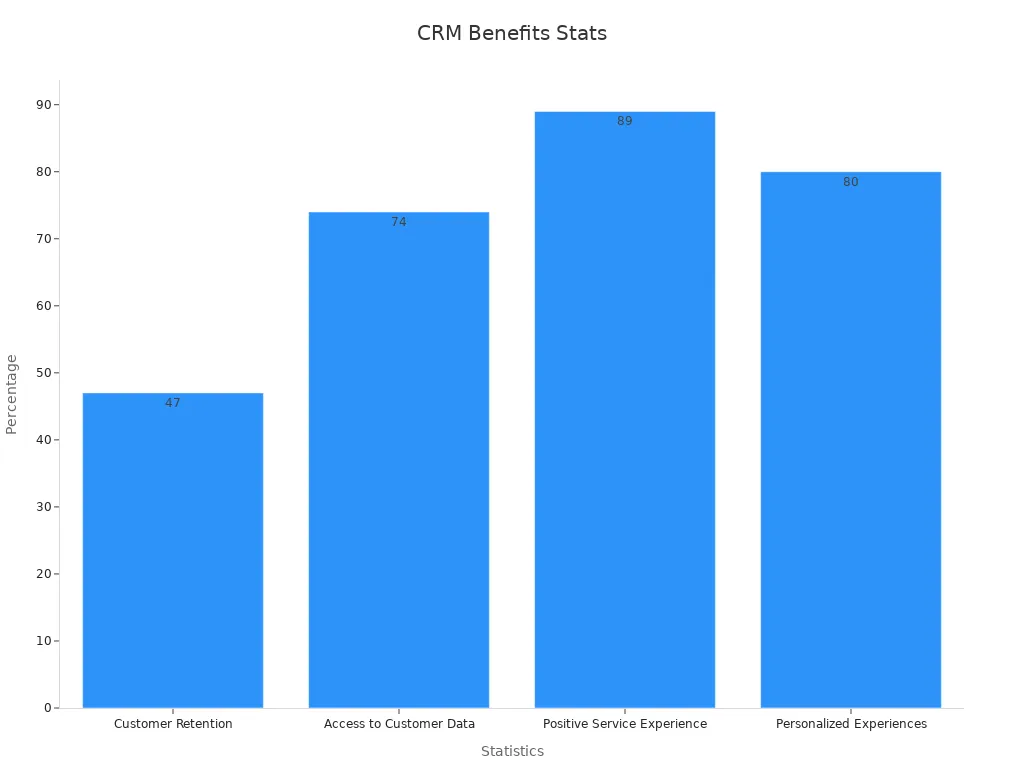Top Contact Center Platforms for CRM Integration Success

In today’s fast-paced world, customer relationship management plays a vital role in how businesses thrive. You need tools that simplify communication, streamline operations, and keep all your customer data in one place. That’s where contact center integration with CRM software becomes a game-changer. It connects your systems, making every customer interaction seamless and efficient. By boosting operational efficiency, it also lets your team focus on what matters—keeping customers happy. Solutions like Sobot ensure you’re equipped with the right tools to stay ahead in delivering exceptional service.
Key Features to Look for in Contact Center Software
Seamless CRM Integration Capabilities
When choosing contact center software, seamless CRM integration is a must-have. Why? Because it connects your customer data with your communication tools, creating a unified system that works smarter, not harder. Imagine being able to personalize every interaction with your customers. That’s what CRM integration does—it gives you access to customer history, preferences, and even past issues, all in one place.
Here’s what you gain with seamless CRM integration:
- Enhanced customer engagement through personalized communication.
- Better marketing with targeted campaigns based on customer segmentation.
- Timely and consistent communication using automated workflows.
- Improved sales efficiency and data accuracy.
By integrating your CRM with your call center software, you’re not just improving operations—you’re building stronger relationships with your customers.
Omnichannel Communication Support
Your customers don’t stick to one channel, so why should your contact center? Omnichannel support integration ensures you can meet your customers wherever they are—whether it’s email, social media, live chat, or phone calls.
Did you know that 64% of customer service agents believe having a single view of customer interactions across all channels improves their performance? With omnichannel support, you can do just that. It consolidates all customer interactions into one platform, giving your agents the tools they need to resolve issues faster. Plus, businesses that understand the customer journey report being more customer-centric, which leads to happier customers.
Omnichannel communication support isn’t just about convenience. It’s about creating a seamless experience for your customers and empowering your team to deliver exceptional service.
Scalability and Customization Options
Your business isn’t static, and your contact center software shouldn’t be either. Scalability and customization options ensure your system grows with you, adapting to your needs without missing a beat.
Here’s how scalable and customizable solutions make a difference:
- They handle high call volumes during peak times without compromising performance.
- They support omnichannel integration, boosting customer satisfaction by 25%.
- They improve first-call resolution rates by 20%, saving time for both your team and your customers.
| Outcome | Description |
|---|---|
| High Call Volume Handling | Manage increased call volumes during peak times without performance issues. |
| Omnichannel Support | Achieve a 25% increase in customer satisfaction (CSAT) scores. |
| First-Call Resolution Improvement | See a 20% improvement in first-call resolution rates with omnichannel solutions. |
Whether you’re expanding to new locations or adding new services, scalable and customizable call center software ensures your operations stay smooth and efficient.
Advanced Analytics and Reporting Tools
When it comes to making smarter decisions, advanced analytics and reporting tools are your best friends. These tools give you the power to track, measure, and improve every aspect of your contact center software. They don’t just collect data—they turn it into actionable insights that help you make better choices.
Here’s how these tools can transform your operations:
| Benefit | Description |
|---|---|
| Data-driven decision-making | Analytics provide metrics that help in making informed decisions regarding agent training and scheduling. |
| Improved customer satisfaction | By quantifying customer satisfaction, businesses can enhance their service quality. |
| Optimized resource management | Analytics help in better allocation of resources, reducing costs and improving efficiency. |
Imagine being able to see which agents are performing well or which times of day are busiest. With reporting and analytics, you can adjust your strategies in real time. This means you’re not just reacting to problems—you’re staying ahead of them. Plus, when you know what your customers want, you can deliver better service, which keeps them coming back.
Advanced analytics also help you spot trends. For example, if you notice a spike in customer complaints about a specific product, you can address the issue quickly. It’s like having a crystal ball for your business, but instead of guessing, you’re using solid data.
User-Friendly Interface and Training Resources
Let’s face it—nobody wants to spend weeks learning how to use new software. That’s why a user-friendly interface is so important. The best contact center software makes it easy for your team to hit the ground running.
Here’s what a great interface and training resources can do for you:
- A simple design reduces the learning curve, so your team gets up to speed faster.
- Easy navigation means fewer mistakes and more productivity.
- Features like customization and remote access make the system flexible and efficient.
When your software is intuitive, your agents can focus on helping customers instead of figuring out how to use the tools. And with comprehensive training resources, they’ll feel confident from day one. Whether it’s video tutorials, step-by-step guides, or live support, these resources ensure your team has everything they need to succeed.
A smooth onboarding process doesn’t just save time—it saves money. Your agents will spend less time training and more time delivering excellent service. That’s a win-win for everyone.
Top Contact Center Platforms for CRM Integration


Sobot Voice/Call Center: Intelligent CRM Integration and Global Reach
If you're looking for a call center CRM that combines intelligence with global accessibility, Sobot Voice/Call Center is a standout choice. This platform is designed to simplify communication and enhance customer interactions through seamless integration with CRM systems. Whether you're a small business or a global enterprise, Sobot offers a robust call center solution tailored to your needs.
Here’s what makes Sobot Voice/Call Center exceptional:
- Omnichannel Service: Manage all communication channels—voice, email, chat, and social media—on a unified platform. This ensures consistent and efficient customer interactions.
- Global Number Availability: With access to phone numbers worldwide, you can connect with customers across the globe effortlessly.
- AI-Powered Voicebot: Automate repetitive tasks and improve customer satisfaction with intelligent, AI-powered features.
- Multilingual Support: Communicate with customers in their preferred language, making your service more inclusive and effective.
| Feature | Description |
|---|---|
| Omnichannel Service | Provides a unified platform for various communication channels, enhancing customer interaction. |
| Global Number | Offers voice services with a global reach, allowing businesses to connect with customers worldwide. |
| AI-Powered Voicebot | Utilizes AI for marketing and service, improving efficiency and customer satisfaction. |
| Multilingual Support | Enables communication in multiple languages, catering to a diverse customer base. |
Sobot’s intelligent CRM integration doesn’t just streamline operations—it transforms them. For example, Samsung, a global leader in technology, achieved a 30% increase in agent efficiency and a 97% customer satisfaction rate after implementing Sobot’s all-in-one contact center solution. This demonstrates how Sobot can help businesses deliver exceptional service while boosting productivity.
Nextiva: Quick Setup and CRM Integration
Nextiva is another excellent option for businesses seeking a reliable call center CRM. Known for its quick setup and effective integration with CRM systems, Nextiva helps you get up and running in no time. Its user-friendly interface and advanced analytics make it a favorite among businesses looking to improve their customer service operations.
Here are some key performance metrics that highlight Nextiva’s capabilities:
| Metric Type | Description |
|---|---|
| Customer Satisfaction Score | Measures how satisfied customers are with the service provided. |
| First Response Time | The average time taken to respond to customer inquiries. |
| Resolution Rate | The percentage of issues resolved on the first contact. |
| Metric Type | Description |
|---|---|
| Average Handle Time | The average duration of a customer call. |
| Call Abandonment Rate | The percentage of calls that are abandoned before being answered. |
| Service Level | The percentage of calls answered within a specific time frame. |
Nextiva’s integration with CRM systems enhances analytics, increases productivity, and reduces operational costs. These benefits make it a strong contender for businesses aiming to optimize their call center software integration.
Five9: AI-Driven CRM Integration for Enhanced Efficiency
Five9 takes CRM integration to the next level with its AI-driven features. This platform focuses on improving agent efficiency and reducing operational costs, making it an ideal choice for businesses of all sizes. Its AI-powered tools help automate workflows, analyze customer data, and provide actionable insights.
Here’s how Five9 delivers measurable results:
| Evidence Type | Percentage |
|---|---|
| Companies improving agent efficiency | 38.94% |
| Respondents expecting cost savings of up to 10% | 30.29% |
| Respondents expecting cost savings of up to 20% | 28.85% |
| Respondents expecting cost savings of up to 30% | 19.23% |
| Large companies expecting cost savings of up to 10% | 29.09% |

With Five9, you can expect faster response times, improved agent productivity, and significant cost savings. Its AI-powered features make it a powerful tool for businesses looking to enhance their call center CRM capabilities.
Dialpad: AI Coaching and CRM Integration
Dialpad stands out as a call center CRM that combines AI coaching with seamless CRM integration. It’s designed to help your team perform better by analyzing calls in real time and providing actionable insights. Imagine having a tool that not only tracks customer interactions but also helps your agents improve their communication skills on the spot. That’s what Dialpad offers.
Here’s why Dialpad’s AI coaching is a game-changer:
- Real-Time Call Analysis: Dialpad listens to calls as they happen and provides instant feedback to agents. This helps them adjust their approach and deliver better service.
- Tailored Insights: The AI analyzes customer sentiment and suggests responses, making conversations more effective.
- Performance Boost: Teams using Dialpad are 4.9 times more likely to hit their targets compared to those without AI tools.
| Metric | Result |
|---|---|
| Likelihood of hitting targets | 4.9 times more likely compared to teams without AI tools |
| Increase in leads and appointments | 50% increase reported by sales professionals |
"The AI-driven insights it provides are so helpful and accurate, which helps my team of sales reps tailor their pitches and responses. The ability to analyze calls in real time is incredible."
Dialpad doesn’t just improve your team’s performance; it transforms how you interact with customers. Its CRM integration ensures all customer data is accessible, making every interaction personalized and efficient. Whether you’re managing a small team or a large contact center, Dialpad’s AI-powered tools make it easier to deliver exceptional service.
CloudTalk: Specializing in CRM Integration
CloudTalk is a call center CRM built with one goal in mind—making CRM integration simple and effective. If your business relies heavily on CRM systems, CloudTalk is the perfect match. It specializes in connecting your call center software with your CRM, ensuring all customer data flows seamlessly between platforms.
Here’s what makes CloudTalk unique:
- Effortless Integration: CloudTalk connects with popular CRM systems like Salesforce, HubSpot, and Zendesk. This means you can access customer data without switching between tools.
- Customizable Workflows: You can set up workflows that match your business needs, automating repetitive tasks and saving time.
- Global Reach: With phone numbers available in over 140 countries, CloudTalk lets you connect with customers worldwide.
| Feature | Benefit |
|---|---|
| CRM Integration | Access customer data directly from your call center software, improving efficiency. |
| Customizable Workflows | Automate tasks and create workflows tailored to your business needs. |
| Global Number Availability | Reach customers in over 140 countries with ease. |
CloudTalk’s focus on CRM integration makes it a favorite among businesses looking to streamline their operations. It’s not just about connecting systems—it’s about creating a unified platform that works smarter, not harder. With CloudTalk, you can improve customer satisfaction, boost agent productivity, and make your call center software integration seamless.
8×8: Customizable CRM Integration Solutions
When it comes to flexibility, 8×8 is hard to beat. This call center CRM offers customizable CRM integration solutions that adapt to your business needs. Whether you’re a small startup or a large enterprise, 8×8 lets you tailor its features to match your goals.
Here’s how 8×8 helps you succeed:
- Custom Integration: 8×8 works with your existing CRM systems, ensuring all customer data is connected and accessible.
- Omnichannel Support: Manage voice, video, chat, and email interactions on a single platform.
- Scalable Solutions: As your business grows, 8×8 scales with you, handling higher call volumes without compromising performance.
| Feature | Description |
|---|---|
| Custom Integration | Connects seamlessly with your CRM systems, improving data accessibility and workflow efficiency. |
| Omnichannel Support | Provides a unified platform for managing multiple communication channels. |
| Scalability | Handles increased call volumes during peak times, ensuring smooth operations. |
8×8’s customizable solutions make it easy to adapt to changing business needs. Its CRM integration ensures your team has the tools they need to deliver personalized service, while its scalability keeps your operations running smoothly. With 8×8, you’re not just choosing a call center CRM—you’re choosing a partner that grows with you.
Avaya: Trusted Telecom and CRM Integration
Avaya has earned its reputation as a trusted telecom provider by delivering reliable solutions that integrate seamlessly with CRM systems. If you’re looking for a call center crm that combines robust voice capabilities with advanced features, Avaya is a solid choice. Its AXP solution bundles take efficiency to the next level, offering tools like AI noise removal, CRM integration, and detailed reporting. These features ensure your team can focus on delivering exceptional service without worrying about technical hiccups.
Here’s why Avaya stands out:
- Integrates with on-premises voice PBX systems, making it ideal for businesses with existing infrastructure.
- Works smoothly with popular third-party software like Salesforce CRM, ServiceNow, and Microsoft Office 365.
- Offers customization options for workflows, letting you tailor the system to your specific needs.
| Measurement Category | Avaya Performance | Competitor Performance |
|---|---|---|
| Product Satisfaction | Leads in product reliability | Cisco scores higher for technology |
| Vendor Experience | Leads in billing practices | Cisco comes out ahead in support |
| Customer Delight | Tied | Tied |
Avaya’s ability to integrate with CRM systems and optimize workflows makes it a favorite among businesses. Whether you’re managing a small team or a large enterprise, Avaya’s solutions help you deliver consistent and efficient service.
Tip: If your business relies on on-premises systems, Avaya’s compatibility with voice PBX and CRM platforms ensures a smooth transition to modern contact center operations.
Talkdesk: Advanced Call Routing with CRM Integration
Talkdesk is a leader in advanced routing capabilities, making it a top choice for businesses that need smarter call center crm solutions. Its integration with CRM systems like Salesforce enables your team to identify customer needs quickly and route calls efficiently. This means fewer delays and happier customers.
Take ServiceTitan, for example. They needed a more sophisticated solution to handle their growing customer base. By integrating Talkdesk with Salesforce, they achieved:
- First call resolution rates above the industry standard (70-79%).
- A 7-minute reduction in average time to answer.
- A 1-minute decrease in average handle time.
Talkdesk’s routing features don’t just improve efficiency—they transform how your team interacts with customers. With intelligent call routing, your agents can focus on solving problems instead of wasting time on misdirected calls.
Note: Businesses using Talkdesk report higher customer satisfaction rates due to faster resolutions and better call handling.
Genesys: Comprehensive CRM Integration Features
Genesys takes CRM integration to a whole new level. Its call center crm solutions use AI to optimize engagement across digital channels, tailoring interactions based on customer data and preferences. This isn’t just about connecting systems—it’s about creating meaningful connections with your customers.
| Evidence Description | Contribution to Contact Center Operations |
|---|---|
| Genesys Cloud utilizes AI to optimize engagement across digital channels. | Enhances customer interactions by tailoring them based on data and preferences. |
| AI integration elevates customer engagement and improves interaction quality. | Fosters deeper connections with customers through enhanced service approaches. |
| Personalized engagements lead to increased efficiency for agents. | Streamlines workflows, improving job satisfaction and productivity. |
| Integration with third-party applications centralizes customer data. | Improves agent productivity by creating seamless workflows across platforms. |
Genesys doesn’t just improve customer interactions—it boosts agent productivity too. By centralizing customer data and automating workflows, Genesys helps your team work smarter, not harder.
Imagine a system that knows your customers better than you do. Genesys uses AI to analyze customer behavior, predict needs, and provide personalized solutions. This means every interaction feels tailored, leaving your customers impressed and satisfied.
Tip: If you want to elevate your contact center platforms, Genesys’s AI-driven CRM integration is a game-changer.
Salesforce Service Cloud: Enterprise-Level CRM Integration
When it comes to enterprise-level CRM integration, Salesforce Service Cloud stands out as a powerhouse. It’s designed to handle the complexities of large-scale operations while keeping things simple for your team. If you’re managing a growing business or a global enterprise, this platform has the tools you need to deliver exceptional customer service.
Why Choose Salesforce Service Cloud?
Salesforce Service Cloud isn’t just another CRM tool. It’s a complete solution that connects your customer service team with the data and insights they need to succeed. Here’s why it’s a favorite among enterprises:
- Scalability: Whether you’re handling hundreds or thousands of customer interactions daily, Salesforce Service Cloud scales effortlessly to meet your needs.
- Customizable Workflows: You can tailor workflows to match your business processes, ensuring efficiency at every step.
- AI-Powered Insights: With Einstein AI, you get predictive analytics and recommendations that help your team make smarter decisions.
Tip: If your business deals with high case volumes, Salesforce Service Cloud’s automation features can save your team hours of manual work.
How Does It Perform?
Salesforce Service Cloud delivers measurable results that prove its effectiveness. Let’s take a closer look at some key success metrics:
| Success Metric | Description |
|---|---|
| Customer Satisfaction Scores | Measures the level of satisfaction among users. |
| Response and Resolution Times | Tracks improvements in how quickly issues are resolved. |
| Case Volume and Trends | Monitors the number of cases and identifies trends in customer issues. |
These metrics show how Salesforce Service Cloud helps businesses improve customer satisfaction, speed up issue resolution, and gain valuable insights into customer behavior.
Features That Make a Difference
Salesforce Service Cloud is packed with features that set it apart. Here are a few highlights:
- Omnichannel Support: Manage customer interactions across email, chat, phone, and social media—all from one platform.
- Knowledge Base: Create a self-service portal where customers can find answers to common questions, reducing the load on your team.
- Integration Capabilities: Seamlessly connect with other tools like Slack, Tableau, and third-party CRMs to create a unified system.
Imagine this: A customer reaches out via live chat with a question about their order. Your agent, using Salesforce Service Cloud, instantly sees the customer’s purchase history, previous interactions, and even suggested solutions from the knowledge base. The result? A faster resolution and a happier customer.
Is It Right for You?
If you’re looking for a CRM solution that grows with your business, Salesforce Service Cloud is worth considering. It’s built for enterprises but flexible enough to adapt to businesses of all sizes. Whether you’re focused on improving response times, managing high case volumes, or delivering personalized service, this platform has you covered.
Note: Salesforce Service Cloud’s robust analytics and AI-driven insights make it a game-changer for businesses aiming to stay ahead in customer service.
With Salesforce Service Cloud, you’re not just investing in software—you’re investing in a better experience for your customers and your team. It’s a tool that empowers you to deliver service that’s not just good but exceptional.
Benefits of CRM Integration in Contact Centers

Enhanced Customer Experience
When you integrate CRM into your contact center, you’re not just improving operations—you’re enhancing customer experience. Imagine this: a customer calls your support team, and the agent instantly sees their purchase history, preferences, and past interactions. This level of personalization makes customers feel valued and understood.
Studies show that 80% of consumers are more likely to buy from companies offering personalized experiences. Plus, businesses that excel in customer experience often see double the revenue growth compared to their competitors. CRM integration also boosts customer retention by 27%, ensuring your customers keep coming back.
Here’s a quick look at how CRM integration impacts customer service:
| Statistic | Percentage | Description |
|---|---|---|
| Customer Retention | 47% | Businesses report significant improvement in customer retention. |
| Access to Customer Data | 74% | Improved access to data helps businesses understand customer behavior. |
| Positive Experiences | 89% | Customers say positive experiences influence repeat purchases. |
| Personalized Experiences | 80% | Consumers prefer companies offering personalized experiences via CRM tools. |

By enhancing customer engagement through CRM, you’re not just solving problems—you’re building loyalty and trust.
Improved Agent Productivity
CRM integration doesn’t just benefit customers—it makes your agents’ jobs easier too. With quick access to customer data, agents spend less time searching for information and more time solving problems. This boosts their confidence and efficiency.
On average, CRM systems save employees 5-10 hours per week. They also reduce the sales cycle by up to 14 days and increase sales productivity by 94%. These numbers highlight how CRM integration directly contributes to improving agent productivity.
| Statistic | Value |
|---|---|
| Increase in sales revenue post-CRM | 21-30% |
| Time saved by employees per week | 5-10 hours |
| Increase in sales productivity | 94% |
| Average sales cycle reduction | 8-14 days |
| Decrease in customer acquisition costs | 91% |
| Higher customer retention rates | 93% |
When your agents have the right tools, they can focus on delivering exceptional service. This not only improves their performance but also creates a better experience for your customers.
Streamlined Data Management
Managing customer data can be overwhelming, especially when it’s scattered across multiple systems. CRM integration solves this by creating a single source of truth for all your customer information.
With real-time data sharing, your agents can access accurate and up-to-date information instantly. This reduces errors and ensures smoother operations. Automated workflows also eliminate repetitive tasks, allowing your team to focus on what really matters—helping customers.
| Benefit | Description |
|---|---|
| Enhanced Customer Experience | Personalized interactions improve customer satisfaction significantly. |
| Improved Agent Productivity | Quick access to relevant customer data allows for more informed responses. |
| Streamlined Operations | Automation of routine tasks reduces errors and ensures accurate customer information. |
Tip: Streamlined data management doesn’t just improve efficiency—it enhances communication between departments, leading to faster issue resolution and better teamwork.
By integrating CRM into your contact center, you’re not just organizing data—you’re empowering your team to deliver better service and achieve greater results.
Better Decision-Making with Analytics
When it comes to running a successful contact center, making informed decisions is key. That’s where analytics step in. By integrating CRM with your contact center, you gain access to powerful tools that turn raw data into actionable insights. These insights help you understand what’s working, what’s not, and where you can improve.
Imagine this: You’re reviewing your team’s performance, and analytics show that customer satisfaction drops during peak hours. With this information, you can adjust staffing levels or implement AI tools to handle the extra load. That’s the power of data-driven decision-making.
Here’s how analytics can transform your contact center:
- Identify Trends: Spot patterns in customer behavior, like common complaints or peak call times.
- Optimize Resources: Use data to allocate agents where they’re needed most, reducing wait times.
- Improve Training: Pinpoint areas where agents struggle and provide targeted coaching.
- Boost Customer Satisfaction: Analyze feedback to understand what makes customers happy and replicate it.
| Benefit | How It Helps |
|---|---|
| Trend Identification | Helps you predict customer needs and prepare in advance. |
| Resource Optimization | Ensures your team is always ready to handle demand. |
| Targeted Training | Improves agent skills, leading to better service. |
| Enhanced Customer Loyalty | Keeps customers coming back by addressing their concerns effectively. |
Tip: Don’t just collect data—use it! Analytics are only valuable if you act on the insights they provide.
With the right analytics tools, you’re not guessing anymore. You’re making decisions based on facts. That means fewer mistakes, happier customers, and a more efficient team. So, start leveraging analytics today and watch your contact center thrive!
How to Choose the Right Contact Center Platform
Assessing Business Needs and Goals
Choosing the right contact center platform starts with understanding your business needs. What are your goals? Are you looking to improve customer satisfaction, streamline operations, or boost agent productivity? Defining these objectives helps you narrow down your options.
“We’ve all been there; after years of loyal custom, we call a business’s contact center and even though they have all our details on file, they still don’t know who you are and why you are calling. And this is even though you have called 3 times this week about the same issue and repeated yourself to 3 different people. The data is there, it just needs the right platform to bring it all together.” – Jonathan Barouch, CEO & Founder, Local Measure
To avoid frustrating your customers, focus on platforms that:
- Preserve context in conversations.
- Unify communication channels with an intuitive omnichannel platform.
- Leverage integrations to combine features and data.
- Automate repetitive tasks to free up agents for complex issues.
Additionally, set SMART goals—Specific, Measurable, Attainable, Relevant, and Time-bound. Regularly review these goals through team meetings and performance evaluations to ensure alignment with your business strategy.
Evaluating Integration Capabilities
Integration is key when selecting a contact center platform. A good system should work seamlessly with your existing tools, especially your crm. This ensures all customer data flows smoothly, creating a unified experience for both agents and customers.
Here are some metrics to evaluate integration capabilities:
| KPI | Description |
|---|---|
| First call resolution (FCR) | Percentage of customer issues resolved in a single interaction. |
| Average handle time (AHT) | Average time taken to resolve a customer concern, including talk, hold, and transfer times. |
| Customer satisfaction (CSAT) | Feedback from customer surveys indicating satisfaction with recent interactions. |
When evaluating platforms, look for those that improve these metrics. For example, a system with strong integration capabilities can reduce AHT by providing agents with instant access to customer data. This not only saves time but also enhances the overall customer experience.
Considering Scalability and Future Growth
Your business will grow, and your contact center platform should grow with it. Scalability ensures your system can handle increased call volumes, new communication channels, and additional users without compromising performance.
Here’s why scalability matters:
| Metric/Strategy | Description |
|---|---|
| Customer Satisfaction | Scaling support can enhance customer satisfaction, which is vital for retention as the company grows. |
| Support Infrastructure | Upsizing support infrastructure is essential when seeking investments or entering new markets. |
| Standards and KPIs | Establishing standards ensures consistent service quality during growth. |
| Onboarding Process | Improving onboarding reduces customer service requests, showing a proactive approach to scalability. |
A scalable platform also supports future innovations like AI tools and advanced analytics. This keeps your business competitive and ready for new challenges. So, when choosing a platform, think long-term. Will it meet your needs five years from now? If yes, you’re on the right track.
Comparing Costs and ROI
When choosing a contact center platform, understanding the costs and potential return on investment (ROI) is crucial. You want to ensure that every dollar spent delivers value, whether it’s through better customer experiences or improved operational efficiency. Let’s break down the key cost factors and how they impact your ROI.
Key Cost Components
Here’s a quick look at the typical costs you’ll encounter when implementing a contact center platform:
| Costs | Description | Details |
|---|---|---|
| Implementation and Integration | Setting up the platform and connecting it to your existing systems. | * Setup fees * Hardware (if needed) * Software licenses * CRM integration |
| Training and Onboarding | Preparing your team to use the new system effectively. | * In-person training * Online courses and materials |
| Migration | Transferring data from old systems to the new platform. | * Customer records * Interaction history |
| Subscription Fees | Recurring costs for using the platform. | * User licenses * Minutes * Messages * API calls |
| Scalability | Expenses for scaling up as your business grows. | * Adding seats |
These costs may seem like a lot upfront, but the right platform can deliver significant returns.
Evaluating ROI
Investing in a contact center platform isn’t just about cutting costs—it’s about driving growth. Did you know that 75% of consumers prefer businesses that recognize them by name and remember their shopping history? Personalization like this boosts loyalty and repeat purchases. Plus, companies that excel in customer experience grow revenues 4-8% higher than their competitors.
Here’s how you can measure ROI:
- Customer Retention: Happy customers stick around. A great platform helps you retain more customers, reducing churn.
- Agent Productivity: Tools that streamline workflows save time, letting agents handle more interactions.
- Revenue Growth: Better customer experiences lead to higher sales. In fact, 94% of consumers who rate a company’s service as “very good” are more likely to buy again.
Tip: Focus on platforms that balance upfront costs with long-term benefits. A scalable, efficient system pays for itself through improved customer satisfaction and increased revenue.
By comparing costs and ROI, you can make an informed decision that benefits both your customers and your bottom line.
CRM integration is the backbone of a successful contact center. It connects your tools, streamlines operations, and helps you deliver personalized service. With a unified view of customer data, you can understand their needs better and provide faster, more effective support.
Here’s why CRM integration matters:
- Real-time access to customer data improves interaction quality.
- Centralized information boosts team collaboration and accountability.
- Personalized service increases customer satisfaction and loyalty.
| Benefit | Description |
|---|---|
| Enhanced Customer Insights | CRM integration provides a unified view of customer data, leading to better understanding of customer needs. |
| Increased Productivity | Streamlined processes reduce time spent on administrative tasks, allowing agents to focus on customer interactions. |
| Improved Customer Service | Access to comprehensive customer information enables agents to provide personalized support. |
| Streamlined Internal Communication | Integration facilitates better collaboration among teams, ensuring everyone has access to the same information. |
Choosing the right platform, like Sobot Voice/Call Center, ensures you’re equipped to meet these goals. Take the time to evaluate your business needs and explore the options. The right choice can transform your operations and elevate your customer service to new heights.
FAQ
What is CRM integration, and why does it matter for contact centers?
CRM integration connects your contact center software with your customer relationship management system. It matters because it gives you a unified view of customer data, helping you personalize interactions, improve efficiency, and deliver better service. It’s the key to happier customers and smoother operations.
How does CRM integration improve agent productivity?
It simplifies your agents’ workflow by giving them instant access to customer data. They don’t waste time switching between systems or searching for information. Instead, they focus on solving problems quickly and effectively, which boosts their confidence and performance.
Can CRM integration work with existing tools?
Yes! Most modern contact center platforms, like Sobot Voice/Call Center, offer seamless integration with popular CRM tools. Whether you use Salesforce, HubSpot, or another system, these platforms ensure smooth data flow and compatibility.
Is CRM integration suitable for small businesses?
Absolutely! CRM integration isn’t just for big companies. Small businesses benefit from streamlined operations, better customer insights, and improved service quality. Platforms like Sobot are scalable, so they grow with your business, making them a smart investment.
How do I choose the right contact center platform for CRM integration?
Start by assessing your business needs. Look for features like seamless CRM integration, scalability, and analytics. Compare costs and potential ROI. Platforms like Sobot Voice/Call Center offer robust solutions tailored to businesses of all sizes, ensuring you get the best value.
See Also
Comprehensive Overview of Omnichannel Call Center Tools
Essential Characteristics of CRM Call Center Solutions
A Decalogue for Adopting Omnichannel Contact Center Systems
